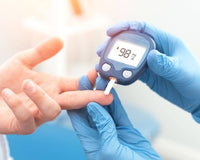Acid reflux, heartburn, indigestion, and gastroesophageal reflux disease (GERD) are common conditions that affect the stomach, esophagus, and digestive tract. Though they are all experienced by most people, these four conditions are often mistaken for each other. Acid reflux and its chronic form, GERD, are specific conditions, while indigestion and heartburn are much more broad terms used to describe pain and discomfort in the chest. In the following article we discuss and differentiate between acid reflux, heartburn, indigestion, and gastroesophageal reflux disease (GERD).
What Is Acid Reflux?
Acid reflux is a chronic condition in which stomach contents unintentionally rise up into the esophagus, resulting in various symptoms and complications. Acid reflux can cause heartburn and other symptoms including cough, sore throat, and a sour or bitter taste in the mouth
Acid reflux is often the fault of poor closure of the lower esophageal sphincter (LES), a ring of valve-shaped muscle that bridges the lower esophagus and stomach. Normally, the LES stays closed, except when swallowing. However, in the case of acid reflux, the LES may open randomly, resulting in stomach acid rising back into the throat.
What Is Heartburn?
Heartburn is a side effect of acid reflux characterized by a burning pain in the chest, usually just behind the breastbone. Pain from heartburn is often the worst after eating or when lying down. While occasional heartburn is usually no cause for concern, persistent heartburn may be a sign for concern.
Heartburn often occurs after you swallow food. After swallowing, food makes its way down the esophagus and into the stomach. After food enters the stomach, a muscle called the lower esophageal sphincter closes to keep the food in. Sometimes, the lower esophageal sphincter does not work properly, causing food and stomach acid to flow back into the esophagus.
What Is Indigestion?
Indigestion, also known as dyspepsia and upset stomach, is characterized by discomfort in the upper abdomen. It is a term used to describe a group of recurring symptoms that contribute to stomach and abdominal pain. Symptoms of indigestion may include abdominal pain, burning in the stomach, bloating, belching and gas, nausea, and vomiting.
Indigestion is a much more broad term than acid reflux or GERD. It refers to any discomfort in the upper abdomen and can be a symptom of various digestive diseases. Indigestion can be brought on by many factors including eating too quickly, drinking too much caffeine, smoking, anxiety, and consuming carbonated beverages.
In most cases, indigestion can be easily treated by avoiding certain foods, stopping smoking, and eating slower. Foods high in fat, such as chips and cheese, alcohol, juice, soda, and coffee can all contribute to indigestion. Indigestion may also be caused by lying down immediately after eating, as this can prevent food from properly entering the digestive tract.
What Is GERD?
Gastroesophageal reflux disease occurs when stomach acid flows back into the esophagus. It is diagnosed when acid reflux occurs more than twice a week or results in inflammation in the esophagus.
Many people who experience acid reflux and heartburn believe they are also suffering from GERD. However, GERD is a more serious, chronic condition often caused by long term habits or anatomy. Acid reflux often causes mild discomfort that goes away shortly. On the other hand, symptoms of GERD are often persistent and can inhibit eating and drinking for long periods of time.
Differences Between Acid Reflux, Heartburn, Indigestion, And GERD
Acid reflux, heartburn, indigestion, and GERD are conditions and symptoms that all involve the stomach and esophagus. Itcan be difficult to distinguish the characteristics, causes, and side effects of each of these four conditions because they all occur in and around the stomach. Knowing the differences between these conditions can help you understand and treat them better.
The Cause: Acid Reflux
Acid reflux occurs when the contents of the stomach travel from the stomach back up the esophagus and into the mouth. The entrance of the stomach contents into the esophagus and mouth causes the burning pain in the chest characterized as heartburn. Acid reflux can also destabilize stomach contents, leading to recurring pain in the stomach known as indigestion, and pain in the chest known as heartburn.
The Symptoms: Heartburn And Indigestion
Heartburn and indigestion are symptoms of acid reflux which occur in different areas of the body. After food and stomach acid unintentionally rise into the esophagus in acid reflux, a burning pain sometimes materializes behind the breastbone or in the neck or throat. This is known as heartburn.
Indigestion is a symptom of acid reflux that can also be brought on by other other causes including smoking, anxiety, eating too much fat or greasy food, and certain antibiotics. It is characterized by discomfort or burning in the upper abdomen, belching, or vomiting.
The Serious Case: GERD
Gastroesophageal reflux disease (GERD) is a much more serious condition than any of the others listed above. It is a chronic condition diagnosed when acid reflux occurs more than twice a week or results in inflammation in the esophagus.
GERD can sometimes result in substantial health complications such as unexplained weight loss and signs of bleeding in the digestive tract. Unlike acid reflux, heartburn, and indigestion, GERD can create a major health problem if not treated over time. In adults, untreated GERD can lead to permanent damage of the esophagus and stomach.
Summary
Acid reflux, heartburn, indigestion, and gastroesophageal reflux disease (GERD) are common conditions that affect the stomach, esophagus, and digestive tract. Acid reflux occurs when stomach conditions unintentionally flow back up into the esophagus from the stomach.
Heartburn and indigestion are symptoms of acid reflux that manifest themselves as pain in the throat and upper chest. GERD, sometimes called chronic acid reflux, is the most serious condition of the four and can cause permanent damage to the esophagus and stomach.








